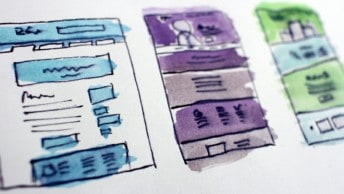If we asked you to list the most important qualities of a UX designer, things like creativity, empathy and technical skills would no doubt spring to mind. But aside from these fundamentals, what really separates the best from the rest?
The answer? Teamwork. The most accomplished UX designers are kings and queens of collaboration. They have mastered the art of communication, and know just how to connect with those around them to leverage fresh perspectives and new ideas – all in the name of great UX.
That’s because great designers recognise that UX is universal. It isn’t merely the aesthetics of a product – it’s a culture, one that puts the user first and determines whether a brand succeeds or fails. UX needs to be a team effort, and more often than not, it’s up to the UX designer to get everyone on board.
To truly excel at your job, you need to make sure that teamwork is at the heart of what you do. This means collaborating effectively and maintaining strong relationships with your peers. So how do you go about this? Look no further than our five key pillars of UX teamwork.
Empathy
There’s a very easy way to become a better team player: empathy. It’s time to practice what you preach, but forget the user for a minute and focus on your colleagues instead. Spend some time getting to know each department, finding out what they do and understanding their goals.
For smoother collaboration with your closest colleagues, it can be useful to step into their shoes for a day or two. Consider picking up some key frontend skills so you can communicate more technically with the developers, or spend a day shadowing the UI team to see how they work.

In the professional world, empathy is important for a number of reasons. The better you know and understand your coworkers, the easier it becomes to recognise how your own work impacts theirs – and vice versa. If you know what motivates your colleagues, the easier it is to pitch your ideas in a way that appeals to them.
Empathy is also key when it comes to handling conflict. Not everyone will like your designs or agree with your decisions, so you need to be ready to discuss, explain and negotiate at any given moment. If you’ve already established a culture of mutual understanding, these conversations will proceed much more smoothly.
Just as empathy for the user enables you to design great experiences, empathy for your colleagues will greatly improve the UX of your professional environment.
Honesty
As a UX designer, you will find yourself working with people who care immensely about the product – but are not necessarily experts in the field of UX. It’s your job to understand their vision and translate it into something that the developers can bring to life. A tricky balancing act if ever there was one.
When bridging the gap between what the stakeholders want and what’s technically possible, managing expectations can be a real challenge. Ultimately, honesty is the best policy. Be realistic about what’s achievable, even if this means having to quash certain ideas as soon as they are put forward. At the same time, be open about your progress and communicate any changes as and when they happen.
An honest, realistic approach keeps everyone on the same page and avoids last-minute surprises. Keep all key stakeholders in the loop at all times and you can’t go wrong.
Trust
Teamwork is all about trust, so make sure your colleagues know that they can rely on you. As Paul Towers points out: “Without each party trusting one another, the ability to come to an agreement or consensus on an issue is always going to be compromised.”
Building trust takes time, but relies on a very simple formula: keep your promises, deliver what you say you will, and meet your deadlines. This ties in with the previous point about honesty: if you’ve agreed on certain design elements with, say, the product manager, make sure you deliver them – or communicate and discuss why you can no longer do so.
How else can you build trust? Through consistency. Be consistent in terms of your methods and actions – even if it’s something seemingly insignificant, such as posting a weekly progress report in the company chat or delivering your work in a certain format. However subtle, establishing certain routines and protocols helps to create structure and reinforce the message that you are trustworthy and dependable.
Inclusivity
Empathy works both ways, so give your colleagues the chance to understand and be part of the UX design process. I’m not suggesting you set them to work on wireframes, but it is important to take an inclusive approach. If you want to encourage a user-first mindset across the whole company, you need to be willing to share what you do.
Why not put together a brief presentation, outlining your methods and processes? Not only does this provide valuable insight into your work, it also helps to build enthusiasm. If you can show your coworkers from other departments just how important user-friendly design is to the overall success of the brand, they will certainly be much more supportive of your mission.
An open mind
Last but not least, go to work with an open mind. Good designers are excellent listeners, always ready to hear new ideas and suggestions. We’re all users, after all, and you can broaden your horizons tenfold if you seek fresh perspectives. Who knows – your colleagues from other departments may just have the solution to your latest UX challenge.
When working on new ideas, invite your coworkers to take a look and provide feedback. Coming from a non-design background, they will be able to tell you if your approach is indeed as user-friendly as you’d hoped. If you really want to experiment with collaborative UX, consider installing a whiteboard in a common space. Jot down your current design challenge and invite others to add their ideas!
Wrap-up
As a UX designer, it can be tempting to operate as a lone wolf. You’ve mastered your craft, after all, and working autonomously often seems like the quickest way to get things done. But to ignore the importance of teamwork is to miss out on the diversity of ideas, inspiration and feedback that is crucial to great UX. With these five strategies, you are well on your way to becoming a better team player – and with it, an even better UX designer.
What do you think are the most important soft skills for UX designers? Leave a comment or let us know in the forums!






“But to ignore the importance of teamwork is to miss out on the diversity of ideas, inspiration and feedback that is crucial to great UX.”
This is a great point, and I also find that it’s crucial to getting buy-in for the UX function in general, and UX methods in particular.
With the abundance of data in business now, coupled with the complete lack of UX skills in data science, it is a great time for UX Designers to start dipping their toes into the basics of analytics. I’d wager failure to do so will even be detrimental to one’s career.